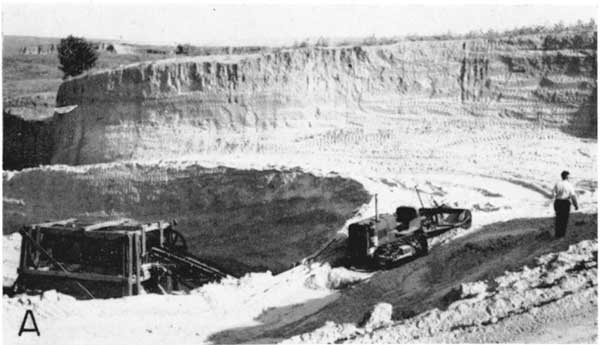Prev Page--Contents || Next Page--Petrography
Introduction
Somewhat more than 90 percent of the surface area of western Kansas is mantled by deposits of Pliocene, Pleistocene, and Recent age. The volcanic ash deposits studied occur as lentils in several stratigraphic positions within the Ogallala formation of Pliocene age and the younger Pleistocene strata. For many years Kansas has been a leading state in the commercial production of volcanic ash, or "pumicite," and a large number of deposits of this material have been located and recorded. In 1928 Landes (pp. 19-46) referred to 109 known localities of volcanic ash in 29 Kansas counties, and in 1942 Schoewe (in Jewett and Schoewe, 1942, p. 170) reported at least 115 localities of ash in 36 Kansas counties. Since the publication of these reports, several additional localities have been found. However, most of the deposits of major commercial value have been known for many years, and one of the largest pits has been in operation for nearly 40 years (Pl. 1A).
Plate1A--Ogallala volcanic ash exposures in Norton County, Kansas. Mine of Wyandotte Chemicals Corporation at Calvert (samples no. 2-10).

Prior to the past decade and a half, the surficial mantle of western Kansas was generally considered to belong largely to the Ogallala formation. Recent detailed studies have resulted in the placement within the Pleistocene of a large percentage of these deposits, and, further, in the subdivision of the Pleistocene strata in different parts of the state into named stratigraphic units (Frye, 1945). The most extensive ash horizon of southwestern Kansas, the "Pearlette ash," occurs within the Meade formation, and Hibbard (1944) has collected vertebrate fossils of definite Pleistocene age from below this ash at many localities. Other deposits of ash within the Pleistocene strata may be in the same or somewhat different stratigraphic positions. In northern Kansas, particularly in Norton County, extensive deposits of ash occur within the part of the Ogallala formation known as the Krynitzkia zone, and ash that may also belong to the Ogallala but in a higher stratigraphic position was observed in one section. Volcanic ash is known to occur in several stratigraphic positions within the Tertiary and Quaternary formations beyond the boundaries of Kansas in the Great Plains region.
The present petrographic study was undertaken to determine if significant differences exist among the various ash deposits, and if so, to determine whether these differences could be correlated with age and thus be of value for stratigraphic purposes. Bentonite beds have long been used as stratigraphic markers because of their continuity and position independent of facies changes. The chief petrographic problem in the stratigraphic use of bentonites has been the positive identification in the clay of volcanic material, such as glass shards and characteristic volcanic minerals (Pirsson, 1915; Ross, 1925, 1928) and they have been differentiated chiefly upon their relative stratigraphic positions. Unaltered volcanic ash offers a greater possibility of correlation on the basis of physical characteristics than does bentonite. In a region of continental Tertiary and Quaternary deposition such as the Central Great Plains, where individual members of formations cannot be traced over long distances, a petrographic approach to a study of the ash may supply information where other data are absent. The purposes of this paper are (1) the discussion of several properties of volcanic ash which may be used to differentiate between ash falls, with suggestion of their limitations; and (2) the application of some of these criteria to volcanic ash deposits in Kansas. As a prime objective was to determine differences between deposits of different ages, only samples from lentils whose stratigraphic position was established by paleontological or stratigraphic methods were considered.
Thanks are expressed to F. J. Pettijohn and R. C. Moore who have read and criticized the manuscript.
Prev Page--Contents || Next Page--Petrography
Kansas Geological Survey, Geology
Placed on web Aug. 10, 2007; originally published April 1946.
Comments to webadmin@kgs.ku.edu
The URL for this page is http://www.kgs.ku.edu/Publications/Bulletins/64_1/02_intro.html